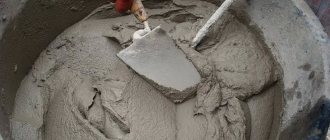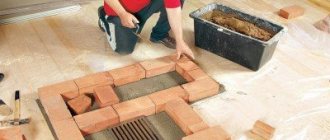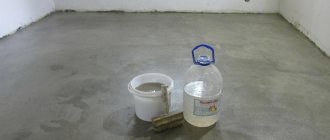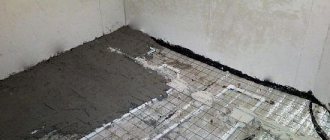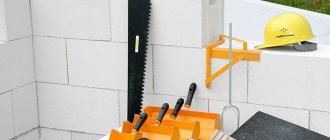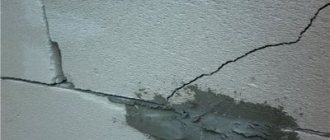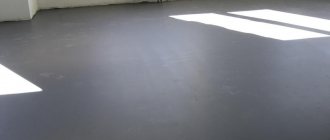1 min. to read
For construction, cement is almost always used, which is mixed in the right proportions with water and sand. This mixture is very viscous and allows you to connect bricks, stones, tiles, and concrete blocks. Cement mortar is used for:
- laying bricks;
- plastering surfaces;
- laying tiles;
- pouring the foundation;
- formation of paths.
If you don’t know how to mix cement, just familiarize yourself with the basic rules. It is not difficult to obtain a mass of the desired consistency.
To work with cement you need various equipment. Especially if large-scale construction is underway.
Brand of concrete and areas of its use
- M100-150 - concrete used for the construction of various non-critical structures that do not perform load-bearing functions. Most often it is used for filling pedestrian paths and sidewalks, since they hardly experience heavy loads;
- M200-250 - often used to cover roads that do not experience heavy loads. In addition, floors and reinforced concrete belts are made from this concrete;
- M300-350 - used in the construction of foundations, floor slabs, roads with heavy loads, staircases, as well as pipes, wells and paving slabs;
- M400-450 is one of the most durable types of concrete. It is used in the construction of high-strength floor slabs, floors in workshops, garages and other facilities where these parts of the building bear a large load. At the same time, with the help of this concrete, foundations and load-bearing structures are created;
- M500 is the strongest concrete grade currently used. It is used in the most critical work, and, unlike other types of this material, it does not lose its properties even in the most difficult operating conditions.
Freezing
The hardening time of the cement coating depends on the class of concrete being strengthened, temperature and humidity.
| Concrete strength class | Temperature, °C | Humidity, % | Freezing time, hours |
| AT 10 | 15-25 | 60-80 | 10 |
| B15 | 15-25 | 60-80 | 7 |
| B25 | 15-25 | 60-80 | 4 |
You can step on the reinforced surface within a day. It will gain average hardness after a week, maximum hardness after 28 days.
Correctly performed treatment with cement laitance, in compliance with technological requirements, extends the service life of concreted and plastered surfaces and brickwork. Keeps them even and smooth. Improves water-repellent properties.
Sand to cement ratio for brickwork
Depending on the brand of cement, its ratio to sand can be different - from 1 to 3 to 1 to 6. The most popular option is the classic mixture, consisting of one part cement to three parts sand. The latter is usually taken from the middle fraction. In this case, the dry ingredients are first mixed until smooth, after which water is poured in. During the mixing process, we achieve such a consistency that the mixture does not flow out when the container is tilted 40 degrees. In this case, the water must be cold (15 degrees) and always clean. Below we present the proportions depending on the brand of cement and other additives:
- Cement-sand mortar with cement grade 500 - 1 part cement to 3 parts sand;
- Cement-sand mortar with cement grade 400 - 1 part cement to 2.5 parts sand;
- Mortar using lime - 1 part cement (500, 400, 300) to 3, 2.5-4 and 3.5 parts sand, as well as 2/10, 1.3/10 and 2/10 parts lime, respectively.
In this case, the amount of water is usually 8/10 parts per 1 part of the cement-sand mixture. In the case of a solution of grade 100, for 1 part of the latter, take from ½ to 7/10 parts of water. The latter solution is precisely used to create brick walls. In the case of mortar grade 115, grade 350 cement is usually used with the appropriate consumption of water and sand. This solution is ideal for laying bricks as part of the external cladding of a building.
How to save borscht set
The battle for the harvest is almost over. However, it is not enough to grow it, you also need to preserve it. Very often, vegetables stored for the winter begin to rot and mold - almost six months of work are canceled out. But it's not too late to do a thorough cleaning of your storage facilities. So what's the matter!
First of all, dry the basements and cellars properly. Open all hatches and doors, increase ventilation. If the humidity is very high, place boxes of charcoal or salt in the corners.
At least once every three years (and if mold and rot appear, then even more often), storage facilities must be disinfected. It is best to treat with freshly slaked lime. Place 2–3 kg of quicklime in a tank, fill it with water and immediately (!) leave the room. Carefully caulk all cracks, hatches, doors and do not open for 2-3 days. Then ventilate the cellar thoroughly. If the result is not achieved, repeat the treatment after 5-6 days.
Is it still damp? Try warming up the storage. But under no circumstances leave the electric heater on for a day or two. It is better to place a bucket of smoldering coals in the cellar - this will ensure both drying and disinfection.
Brand of cement for the foundation and its ratio with sand and crushed stone
The foundation is the most important part of any structure, and the stability, durability and safety of the house will depend on its strength. In this regard, when constructing the foundation, it is necessary to use correctly selected cement. The brand of the latter depends on the load that the foundation part will experience in the future. The grade of concrete means the compressive strength of the hardened composition. The higher the number, the higher the strength, but the higher the price. But when building a foundation, it is contraindicated to skimp on quality.
In the case of concrete preparation, you can use cement grade 100. However, for the construction of the foundation we will use options from M300 and higher. If you want to achieve maximum structural strength, then take the M500, since its price is not much different from the M400. As for the ratio, it is usually 1-3-5 based on cement, sand and crushed stone.
Basic components of concrete
Before starting work, you should study the main components of the concrete composition. The standard concrete formula involves the use of cement, water, sand and fillers of different fractions.
Cement
Cement serves as the main substance that has a binding effect on all elements. The strength of the finished structure and the rate of hardening of the mixture largely depend on its quality. Building materials are classified according to grades, which are selected according to the required type of concrete. Private developers usually use M400 or M500 cement, which allows them to create such reliable structures as country houses, garages, bathhouses, and outbuildings.
Sand
Considering how to make concrete with your own hands, we note that sand is an equally important material that has a direct effect on the properties of the solution. When purchasing it, you need to consider the following points:
- it should not contain clay - the permissible amount of clay particles is 3%;
- optimal sand fraction – from 1.5 to 4 mm;
- volumes of fine fractions up to 0.6 mm cannot be more than 3%.
In many cases, quarry sand containing a significant number of foreign inclusions is used to prepare concrete compositions. Before mixing the solution, such building material must be sifted and washed.
Crushed stone
Crushed stone is the main filler for the solution, which improves the strength parameters of the frozen mass. He may have different factions. For small concrete structures you can use crushed stone ranging in size from 5 to 20 mm, for large structures - in the range of 20–40 mm. When telling how to prepare concrete at home, it should be mentioned that when buying crushed stone you should pay attention to its origin, since this affects the strength class of the resulting composition. Thus, dolomite crushed stone is used for lightweight concrete B15, and granite crushed stone is optimally suited for high-strength structures with class B30. Instead of crushed stone, gravel, slag, and expanded clay can be used.
Water
Water, like other components of the mixture, has certain requirements. It should not contain organic compounds, mechanical particles, alkali or acid. Do not use liquid that is waterlogged or contains petroleum products. It is best to use tap water.
When figuring out how to mix concrete manually, the proportions of the liquid are selected according to the required plasticity and crushed stone fraction.
| Plasticity degree | Crushed stone fraction, mm | |||
| 10 | 20 | 30 | 40 | |
| Maximum | 225 | 210 | 195 | 180 |
| Average | 215 | 200 | 185 | 170 |
| Minimum | 205 | 190 | 175 | 160 |
| Without plasticity | 195 | 180 | 165 | 150 |
The ratio of sand and cement for preparing concrete
When erecting reinforced concrete structures, we must accurately calculate the proportions of the components and the grade of cement. Regarding the latter, you can rely on the description given at the beginning of the article, choosing a brand depending on where exactly the mixture will be used.
As for the composition of concrete, in addition to cement, sand and water, crushed stone, gravel and other solid fractions are often used. At the same time, all this can be mixed in very different proportions, depending on the task and the master carrying out the work. As practice shows, the most common combination is: 1 part cement, 4 parts crushed stone, 2 parts sand and ½ part water. But here it is necessary to take into account various additives that give concrete certain properties. If we use them, we will have to act according to the instructions.
Mixing methods
To mix the solution with your own hands, you can use two methods - manually or using a concrete mixer. The choice of one option or another depends on the required volumes of the composition.
Manually
First, let's look at how to mix concrete mixture by hand. This method is simple and does not require the use of special equipment. To carry out the work, you only need to prepare a suitable container, bucket and shovel. Manual mixing is suitable for preparing small volumes of mortar, for example when constructing a fence or building a blind area.
The entire mixing process is performed as follows:
- Sand is poured into a trough or unnecessary bath, and cement powder is added on top.
- Mix the ingredients well until smooth.
- Measure out the required amount of water and pour it into the trough in small doses. At the same time, stir and distribute over the surface of the container.
- After obtaining a homogeneous mixture without lumps, add crushed stone. Mix until all the crushed stone is covered with the solution.
- When figuring out how to make concrete with your own hands, we point out that if you need to achieve greater plasticity, add water.
Concrete mixer
Using a concrete mixer is a simpler option that does not require manual labor. The composition is prepared as follows:
- Part of the water is poured into the equipment drum and all the prepared cement is poured. Stir until a gray emulsion forms. After this, the concrete mixer should work continuously.
- At the second stage, crushed stone and sand are added and stirred for several minutes. When considering how to mix the solution, keep in mind that after this you need to pour the remaining liquid into the drum and finally mix the composition.
- Finally, the mixture is unloaded from the concrete mixer and used for its intended purpose. When preparing, it is important to constantly monitor the volume of the composition and try not to overload the drum.
If you figure out how to make concrete, you can easily do all the work yourself. This will allow you to obtain a high-quality mixture without spending money on the purchase and transportation of ready-made compounds.
Author of the article
Ratio for installing plaster and pouring screed
The amount of water in this case can be very different, depending on the task. In this case, the mixture usually consists of cement and sand, diluted in proportions of 1 to 5.
As for the floor screed, an important factor here is strength, which must have a minimum threshold value of 10 MPa. In this case, it is best to select concrete grade M150, since this parameter in its case is 12.8 MPa. In general, the proportions of the mixture can depend on the following factors:
- The need to conceal various communications;
- The degree of leveling and raising of the surface.
You should immediately decide that when screeding floors in houses and apartments, it is best to use a solution of 100 or 150. In general, depending on the required brand of mortar and cement, the dilution parameters with sand may be as follows:
- Mortar 100, cement 200 – 1 part cement to 3 parts sand;
- Mortar 150, cement 300 – 1 part cement to 2 parts sand;
- Mortar 200, cement 300 – equal parts;
- Mortar 150, cement 400 – 1 part cement to 3 parts sand;
- Mortar 200, cement 400 – 1 part cement to 2 parts sand;
- Mortar 300, cement 300 – equal parts.
Important! Pay maximum attention to mixing the cement mortar for your needs. Incorrect proportions of components can compromise the strength of the poured structure. Especially when it comes to foundations, load-bearing structures or floor slabs.
How to properly dilute cement mortar without sand?
To make such a solution, you need to dilute the cement with water. Its addition should be portioned. The mixture should be stirred until it reaches a uniform consistency.
The main rule of using this technology is that such a solution must be used very quickly for your purposes. This rush is due to the fact that the cement will begin to harden quickly and then nothing will be done.
Cement is mostly used as a substance necessary for binding other building materials. Therefore, in its pure form it collapses very quickly and crumbles after hardening.
Features of concrete mortar
The strength of the foundation largely depends on the correctly selected components, each of which is designed to perform its assigned task.
For example, the main components of concrete are cement and water; their mixture forms cement stone. However, despite the monolithic structure, this stone is easily deformed, shrinking 2 mm per 1 meter. The result of this process is the formation of microcracks, invisible during visual inspection, but significantly reducing the quality of the cement. In the future, to analyze the quality and condition of the foundation, it may need to be examined.
Concrete mortar
Fillers help reduce the degree of deformation of cement stone. Most often, sand, crushed stone, gravel or expanded clay are used for this. The filler forms a special structure that absorbs the stress of concrete during the shrinkage process. Consequently, adding a filler to cement makes it possible to increase the strength of concrete several times.
Areas of application of cement
Portland cement is a building material used to perform the following work:
- preparation of concrete of various grades;
- pouring the foundation and floors;
- production of various mixtures for construction, repair and finishing work;
- production of reinforced concrete products (curbs, road slabs, paving stones, etc.) and compositions for creating various objects of decorative and applied art.
Cement acts as a binding component and is used to connect individual parts of structures or brickwork. In order for the finished product to have the stated strength, the mixture must be prepared correctly and using traditional methods.
Proportions for outdoor screed
The ratio of concrete for outdoor screed and its structure differs from the ratio and structure of the components for interior work. When the screed is in the open air, it experiences significant temperature changes, in addition to the negative effects of precipitation and wind.
Sand-gravel concrete (SGMC)
For this reason, you should use M150 and be sure to iron the top layer. Ratio of concrete screed used outdoors:
- 1 share of M400 cement, 4 shares of the purest river sand, 5.5 shares of crushed granite, 0.9 shares of water.
- 1 share of M500 cement, 4.1 shares of the purest river sand, 5.5 shares of granite crushed stone, 0.7 shares of water.
Tables of proportions for the main types of cement mortars
The cement is a cementitious mortar of the selected brand, where M300 or M100 indicates the load that it can withstand. Instructions for the use of mortars CH 290-74 have tables with strictly regulated proportions. Construction mortars can be divided into the following types: plaster (M10, M25, M50), masonry (M50, M75, M100, M125, M150, M200), mortar used for screed (M150, M200, M300, etc.).
Cement consumption in kg per 1 sq.m of sand:
| Cement brand | Brand of solution | ||||||
| M200 | M150 | M100 | M75 | M50 | M25 | M10 | |
| M500 | 360 | 280 | 205 | 160 | — | — | — |
| M400 | 450 | 350 | 255 | 200 | 140 | — | — |
| M300 | — | 470 | 340 | 270 | 185 | 105 | — |
| M200 | — | — | — | 405 | 280 | 155 | — |
| M150 | — | — | — | — | — | 206 | 93 |
To increase the plasticity of the solution, clay or lime is added to the building mixture in the following proportions for foundations in dry soils:
| Cement brand | Volume composition (cement/lime/sand) | ||||||
| M200 | M150 | M100 | M75 | M50 | M25 | M10 | |
| M500 | 1/ 0,2/ 3 | 1/ 0,3/ 4 | 1/ 0,5/ 5,5 | 1/ 0,8/ 7 | |||
| M400 | 1/ 0,1/ 2,5 | 1/ 0,2/ 3 | 1/ 0,4/ 4,5 | 1/ 0,5/ 5,5 | 1/ 0,9/ 8 | — | — |
| M300 | — | 1/ 0,1/ 2,5 | 1/ 0,2/ 3,5 | 1/ 0,3/ 4 | 1/ 0,6/ 6 | 1/ 1,4/ 10,5 | — |
| M200 | — | — | — | 1/ 0,1/ 2,5 | 1/ 0,3/ 4 | 1/ 0,8/ 7 | — |
| M150 | — | — | — | — | — | 1/ 0,3/ 4 | 1/ 1,2/ 9,5 |
For the construction of building structures, foundations and screeds, a mixture of cement with sand and gravel is used in the following proportions:
| Cement brand | Volumetric composition (cement / sand / crushed stone) | ||||||
| M450 | M400 | M300 | M250 | M200 | M150 | M100 | |
| M500 | 1/ 1,2/ 2,5 | 1/ 1,4/ 2,8 | 1/ 2,2/ 3,7 | 1/ 2,4/ 3,9 | 1/ 3,2/ 4,9 | 1/ 4/ 5,8 | 1/ 5,3/ 7,1 |
| M400 | 1/ 1/ 2,2 | 1/ 1,1/ 2,4 | 1/ 1,7/ 3,2 | 1/ 1,9/ 3,4 | 1/ 2,5/ 4,2 | 1/ 3,2/ 5 | 1/ 4,1/ 6,1 |
Cement mortar for foundation
For ease of mixing the mortar, a concrete mixer is used. The classic recipe for the mixture initially requires filling with water. You should proceed from the amount of cement: 1 bucket of cement to 1 bucket of water, as a rule, these components are proportional. To obtain the required consistency of the solution, water must be poured in gradually. If sand is used while it is wet, the amount of water should be reduced.
Professional masons advise adding liquid soap to water when preparing the solution to give it greater elasticity. Water with soap has the greatest fluidity, unlike ordinary water. This mixture will better wet the filler and poured surfaces. Its ability to fill small pores will reduce the number of voids and cavities. Strength and elasticity will increase significantly. Before mixing soapy water with the solution, soap and water must be combined.
As soon as the liquid soap has dissolved and foamed, you can add about half of the prepared sand. After this, cement should be added in full. Next, all components are mixed for about 5 minutes and the rest of the sand is poured. If the solution is not thick enough, add a small amount of water. How do you know the correct consistency of cement mortar? The solution should resemble sour cream, and if you draw something on it, the drawing should leave its outline.
4.8 / 5 ( 6 votes)
Proportions for fence posts
When producing concrete, in order to use it for a columnar fence foundation, it is necessary to adhere to certain ratios:
The proportions in the parts are as follows:
- Concrete M400 - 1 share.
- Gravel or crushed stone - 4 shares.
- Sifted sand - 2 shares.
- Water - 0.5 parts.
Calculation of proportions for the foundation is carried out in buckets.
Making a reliable mixture for the purpose of pouring a foundation for pillars is permissible subject to the following conditions:
- Be sure to use dry cement with a valid expiration date.
- It is recommended to use clean river sand.
- Homogeneous gravel composition.
How to make concrete. Proportions of concrete in buckets. Pouring the foundation

